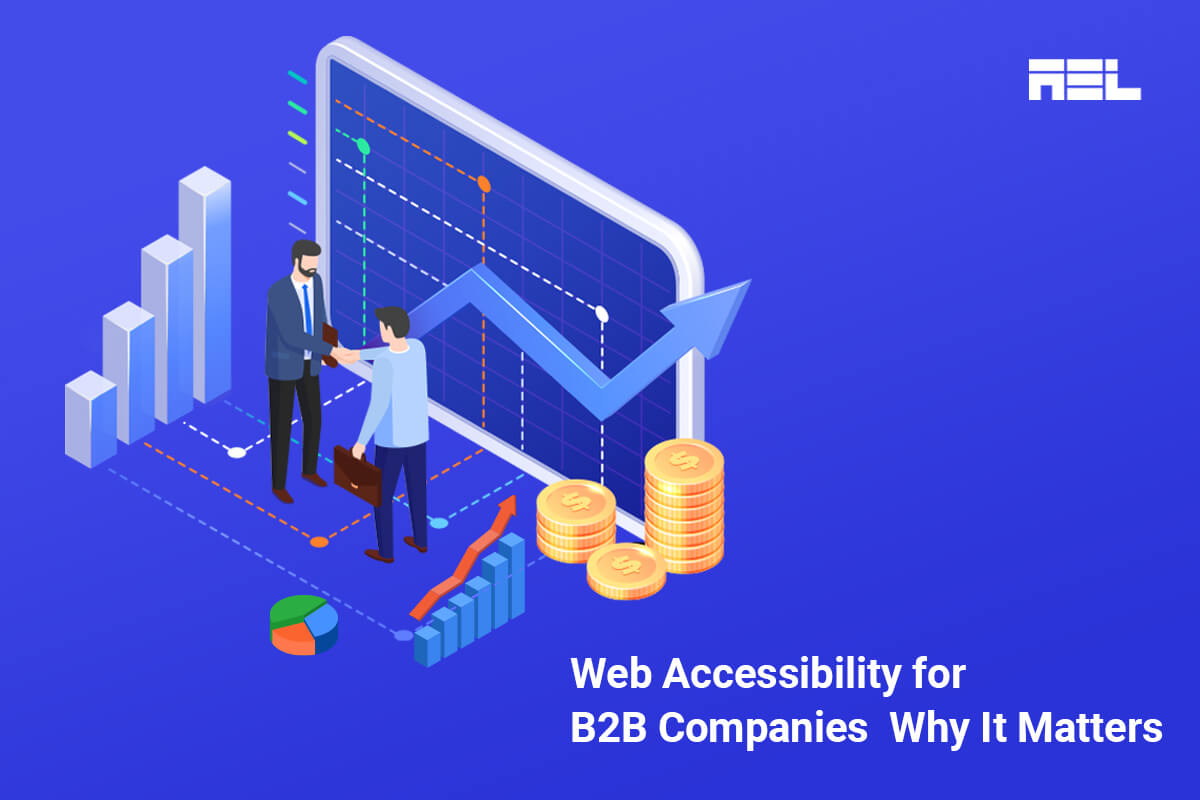B2B companies need to prioritize web accessibility for essential reasons like engagement, enhanced SEO, and broader brand visibility. About 71% of users with disabilities leave sites that aren’t accessible, whereas accessible websites show increased repeat visits.
In today’s digital era, it’s vital for B2B businesses not to exclude potential customers with disabilties, as inaccessible websites present a stark reality.
What is the stark reality here?
Giving importance to digital accessibility goes beyond legal compliance–it’s a strategic necessity. Embracing inclusive design not only meets regulatory standards but also opens up a vast market of diverse clients.
In the current B2B landscape, enhancing user experience, building brand loyalty, aids in remaining ahead in the digital evolution.
In this blog post, we’ll discuss why is it crucial for B2B companies to prioritize web accessibility, its advantages, and its alignment with broader business objectives. We’ll delve into five key reasons why B2B companies need to embrace digital accessibility to thrive in today’s market.
Let’s take a closer look at this shift towards website accessibility. Why are businesses making these changes, and which areas should your company focus on?
Table of Contents
Changes in the Digital World
Digital accessibility isn’t just a concern in the B2B sector, it’s a game-changer. Recent findings from the State of Digital Accessibility survey indicate that 85% of B2B respondents view digital accessibility as a competitive advantage with 64% respondents attributing revenue growth to it.
Yet, a few organizations might not fully grasp the importance of B2B web accessibility. Once they recognize its value, they have the opportunity to enhance their business.
Ethics and Laws in Digital Accessibility
Businesses need to think about web accessibility, particularly regarding legal obligations. While many companies grasp the importance of following the Americans with Disabilities Act (ADA) for physical locations, they often overlook its application in the digital space.
Title III of the ADA prevents discrimination against individuals with disabilities, requiring businesses to guarantee fair access to products and services, including those offered online. Providing reasonable accommodations for both customers and employees using digital tools is essential.
In today’s digital age, making websites accessible is a legal requirement. Many websites are not accessible, which could breach the ADA and hinder people with disabilities. ADA compliance involves ensuring web content accommodates people with visual, cognitive, and auditory impairments. Non-compliance to ADA could result in a lawsuit besides losing the reputation of your brand. Making accessibility a priority helps safeguard your B2B brand and ensures everyone’s needs are met.
In the digital marketing era, creating accessible content for B2B audiences showcases intelligence and ethical business practices.
Does Accessibility Make B2B Websites Better?
For B2B companies, adhering to ADA standards fosters inclusivity. Even users who don’t require accessibility features often prefer websites that offer them.
Web accessibility enhances user experience (UX) through easy navigation, clear text descriptions, and keyboard compatibility. These features benefit everyone, especially those with disabilities.
Accessible websites boost user efficiency, reducing frustration and prolonging engagement. Ultimately, they result in satisfied customers, increased conversion rates, and a flourishing B2B brand.
Why Should B2B Companies Care About Accessibility?
No business wants to hinder a smooth experience for potential customers due to website issues. Inaccessible websites pose usability challenges, especially for individuals with disabilities.
There are several ways to remedy this and a few of them are mentioned below:
- Prioritizing web accessibility for B2B benefits all users, not just a specific group, but by enhancing the overall user experience.
- Implementing features like simple keyboard navigation, clear organization, and descriptive elements removes obstacles that affect everyone’s browsing, not just those with specific requirements.
- Accessibility eliminates barriers, making it easier for everyone to navigate efficiently and find what they need. Tools like screen readers, along with easy-to-understand headings, labels, and alternative text, become crucial for accessing content.
Boosts Public Relations
In today’s landscape, customers and partners gravitate toward brands that mirror their values. As accessibility gains traction in 2024, prioritizing web accessibility positions your B2B organization as an inclusive frontrunner.
- Embracing digital accessibility for B2B sends a compelling message resonating with conscious consumers and partners. It signals your unwavering commitment to equitable access and opportunities.
- Research indicates that 82% of consumers are willing to switch to brands that uphold their social values, with accessibility ranking prominently.
- Accessibility in B2B marketing generates favorable PR. Media outlets take note, customers express gratitude, and partners seek collaboration.
Ensuring your web content is accessible creates a win-win scenario, enhancing your brand reputation and fostering meaningful connections. Conversely, neglecting accessibility may lead to customer backlash and potential legal entanglements.
Improved SEO Performance
For SEO marketers, dominating the search engine realm is the ultimate goal. Web accessibility serves as a mantra, giving businesses an edge over competitors.
- By adhering to B2B accessibility standards, organizations earn favor with search engines, resulting in higher visibility in search results and increased organic traffic.
- Adhering to WCAG (Web Content Accessibility Guidelines) produces content that aligns with search algorithms and user preferences, leading to improved page rankings and enhanced engagement.
Therefore, embracing web accessibility guidelines is essential for boosting both traffic and conversion rates.
Wrapping up
In 2024 and beyond, website accessibility is increasingly important. With an increasing number of people with disabilities and evolving legal requirements, it’s vital for websites to include and be accessible to everyone.
Ensuring your website is accessible can help your business or organization in many ways, now and in the future.If you need any assistance, contact the B2B website accessibility specialists at AEL Data! Contact us for a complimentary consultation to understand your audience’s requirements and obstacles, ensuring your message effectively reaches all your target users.



